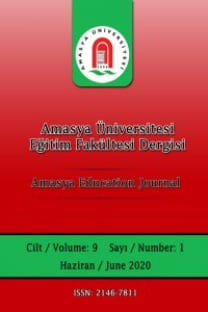Hep Birlikte Daha İleriye: Nice On Yıllara
Investigation of Digital Game Addiction Levels of Sedentary and Sports Students*
Sports, Addiction, Digital game, Sedentary Athlete,
___
- Aktaş, İ., & Karamustafaoğlu, O. (2022). Evaluation of the published articles in educational field: A Bibliometric analysis. Hacettepe University Journal of Education, https://doi.org/10.16986/HUJE.2021067584 (Baskıda)
- Bornmann, L., & Leydesdorff, L. (2017). Skewness of citation impact data and covariates of citation distributions: A large-scale empirical analysis based on Web of Science data. Journal of Informetrics, 11(1), 164-175. https://doi.org/10.1016/j.joi.2016.12.001
- Engels, T.C.E., Ossenblok, T.L.B., & Spruyt, E.H.J. (2012). Changing publication patterns in the Social Sciences and Humanities, 2000-2009. Scientometrics, 93(2), 373-390. https://doi.org/10.1007/s11192-012-0680-2
- Fire, M., & Guestrin, C. (2019). Over-optimization of academic publishing metrics: observing Goodhart’s Law in action. GigaScience, 8(6), giz053. https://doi.org/10.1093/gigascience/giz053
- Henriksen, D. (2016). The rise in co-authorship in the social sciences (1980-2013). Scientometrics, 107(2), 455-476. https://doi.org/10.1007/s11192-016-1849-x Miranda, R., & Garcia-Carpintero, E. (2018). Overcitation and overrepresentation of review papers in the most cited papers, Journal of Informetrics, 12(4), 1015-1030. https://doi.org/10.1016/j.joi.2018.08.006
- Orbay, K., Miranda, R., & Orbay, M. (2020). Building journal impact factor quartile into the assessment of academic performance: A case study, Participatory Educational Research, 7(2), 1-13. https://doi.org/10.17275/per.20.26.7.2
- Orbay, M., Karamustafaoğlu, O., & Miranda, R. (2021). Analysis of the journal impact factor and related bibliometric indicators in education and educational research category, Education for Information, 37(3), 315-336. https://doi.org/10.3233/EFI-200442
- Ossenblok, T.L., Verleysen, F.T., & Engels, T.C. (2014). Co-authorship of journal articles and book chapters in the social sciences and humanities (2000-2010). Journal of the Association for Information Science and Technology, 65(5), 882-897. https://doi.org/10.1002/asi.23015
- Örnek, F., Miranda, R., & Orbay, M. (2021). Investigating the journal impact factor of special education journals Indexed in the Social Sciences Science Edition from Web of Science, Journal of the American Academy of Special Education Professionals, Winter, 110-132. https://www.naset.org/index.php?id=5772
- Pajić, D., & Jevremov J. (2014). Globally national-Locally international: Bibliometric analysis of a SEE psychology journal. Psihologija, 47(2), 263-267. https://doi.org/10.2298/PSI1402263P
- Sezgin, A., Orbay, K., & Orbay, M. (2022). Educational research review from diverse perspectives: A Bibliometric analysis of Web of Science (2011-2020). Sage Open, SO-21-046 (İncelemede).
- Tonta, Y. (2017). Journals published in Turkey and indexed in Web of Science: An evaluation. Turkish Librarianship, 31(4), 449-482. https://doi.org/10.24146/tkd.2017.21
- ISSN: 2146-7811
- Yayın Aralığı: Yılda 2 Sayı
- Başlangıç: 2012
- Yayıncı: Amasya Üniversitesi
Çağdaş Sanatta Sosyolojik Bir Olgu: Göç
Temellendirilmiş Zihinsel Model Teorisi
Eleştirel Düşünme Becerisi Açısından İlkokul Sınıfları: Bir Karma Yöntem Araştırması
Celal BOYRAZ, Gamze ÇİMEN, Azime TURAN
Hep Birlikte Daha İleriye: Nice On Yıllara
Öğretmenlerin Toprak Kavramına İlişkin Metaforik Algıları
Romantik İlişkilerde Algılanan Sosyal Destek, Bağlanma ve Kadına Yönelik Şiddet Tutumu
Japonya’da Vatandaşlık Eğitimi
Okan YETİŞENSOY, Şemsettin AKDENİZ
Melek ŞENER PARS, Necati CEMALOĞLU
Sedanter ve Spor Yapan Öğrencilerin Dijital Oyun Bağımlılık Düzeylerinin İncelenmesi
